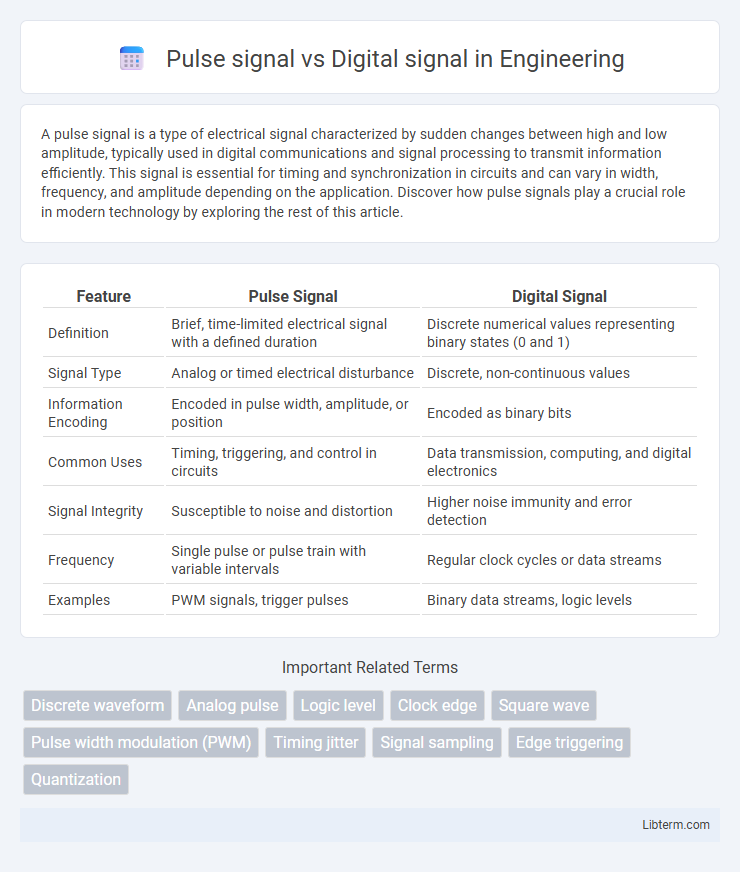A pulse signal is a type of electrical signal characterized by sudden changes between high and low amplitude, typically used in digital communications and signal processing to transmit information efficiently. This signal is essential for timing and synchronization in circuits and can vary in width, frequency, and amplitude depending on the application. Discover how pulse signals play a crucial role in modern technology by exploring the rest of this article.
Table of Comparison
| Feature | Pulse Signal | Digital Signal |
|---|---|---|
| Definition | Brief, time-limited electrical signal with a defined duration | Discrete numerical values representing binary states (0 and 1) |
| Signal Type | Analog or timed electrical disturbance | Discrete, non-continuous values |
| Information Encoding | Encoded in pulse width, amplitude, or position | Encoded as binary bits |
| Common Uses | Timing, triggering, and control in circuits | Data transmission, computing, and digital electronics |
| Signal Integrity | Susceptible to noise and distortion | Higher noise immunity and error detection |
| Frequency | Single pulse or pulse train with variable intervals | Regular clock cycles or data streams |
| Examples | PWM signals, trigger pulses | Binary data streams, logic levels |
Introduction to Pulse and Digital Signals
Pulse signals consist of sudden, short bursts of energy varying in amplitude or duration, commonly used in time-domain communication and digital circuits. Digital signals represent binary data through discrete voltage levels, typically switching between high (1) and low (0) states for robust data transmission and processing. Understanding the characteristics and applications of pulse and digital signals is essential for designing efficient electronic communication and control systems.
Fundamental Definitions
A pulse signal consists of a series of short bursts or pulses of energy separated by intervals of zero amplitude, often used in time-domain communication and control systems. A digital signal represents data using discrete levels or states, typically binary values of 0s and 1s, enabling reliable information processing and transmission. Pulse signals form the physical basis for digital signals by encoding the binary information into timed or gated bursts.
Key Characteristics: Pulse Signal vs Digital Signal
Pulse signals consist of periodic electrical pulses characterized by amplitude, duration, and repetition rate, often used in timing and control systems. Digital signals represent data as discrete binary values (0s and 1s) with specific voltage levels indicating logical states, ensuring noise immunity and ease of processing. Key characteristics distinguishing pulse signals from digital signals include pulse shape variability versus fixed waveform representation and continuous time reference versus discrete data encoding.
Signal Representation and Structure
Pulse signals represent information using discrete bursts of energy characterized by specific amplitude, width, and timing, often depicted as time-domain waveforms with varying pulse intervals. Digital signals consist of binary states, typically represented as square waves with fixed voltage levels corresponding to logic 0 and logic 1, structured in a sequence of bits or symbols. The fundamental difference lies in pulse signals encoding data via pulse parameters while digital signals encode data using standardized voltage levels in a time-structured bitstream.
Transmission Methods
Pulse signals transmit information through discrete bursts of energy, typically using amplitude, width, or position modulation to convey data over time intervals. Digital signals represent data as binary sequences of 0s and 1s, enabling robust error detection and correction during transmission via techniques like pulse code modulation (PCM) and differential signaling. Transmission methods for pulse signals often involve analog pulse shaping and modulation schemes, while digital signals leverage synchronous or asynchronous protocols ensuring higher noise immunity and fidelity in communication systems.
Common Applications
Pulse signals find common applications in radar systems, digital communication, and pulse code modulation where accurate timing and discrete signal representation are critical. Digital signals dominate computing, data transmission, and control systems due to their noise immunity and ease of processing with binary logic. Both signal types are integral in medical imaging and industrial automation, enhancing precision and reliability in measurements and control tasks.
Performance and Reliability
Pulse signals offer high-speed transmission with minimal latency, making them suitable for real-time applications requiring fast response times. Digital signals provide enhanced reliability through error detection and correction mechanisms, ensuring data integrity across noisy channels. Performance in digital signals is often more consistent due to their robustness against signal degradation compared to pulse signals, which can be more susceptible to distortion over long distances.
Advantages and Limitations
Pulse signals offer precise timing control and are effective for synchronizing communication systems, providing clear signal detection with minimal noise interference. Digital signals enable efficient data representation with easier error detection and correction, boosting reliability in digital communication systems. However, pulse signals can be susceptible to distortion over long distances, while digital signals require more bandwidth and complex circuitry for encoding and decoding.
Signal Processing Techniques
Pulse signals are characterized by discrete bursts of energy within a specific time frame, often analyzed using time-domain techniques like pulse shaping and timing recovery to minimize intersymbol interference. Digital signals represent data as sequences of binary values, processed through sampling, quantization, and filtering methods such as digital finite impulse response (FIR) filters and fast Fourier transform (FFT) for frequency analysis. Advanced signal processing techniques like matched filtering and error correction coding enhance the detection and reliability of both pulse and digital signals in noisy communication channels.
Future Trends in Signal Technology
Future trends in signal technology emphasize the integration of pulse signals with advanced digital processing techniques to enhance data transmission speed and accuracy in next-generation communication systems. Innovations like quantum pulse modulation and machine learning algorithms are driving the evolution of digital signals, enabling more efficient bandwidth utilization and reduced latency. Emerging applications in 6G networks and Internet of Things (IoT) devices rely heavily on these hybrid signal technologies to support massive connectivity and real-time data analytics.
Pulse signal Infographic

 libterm.com
libterm.com